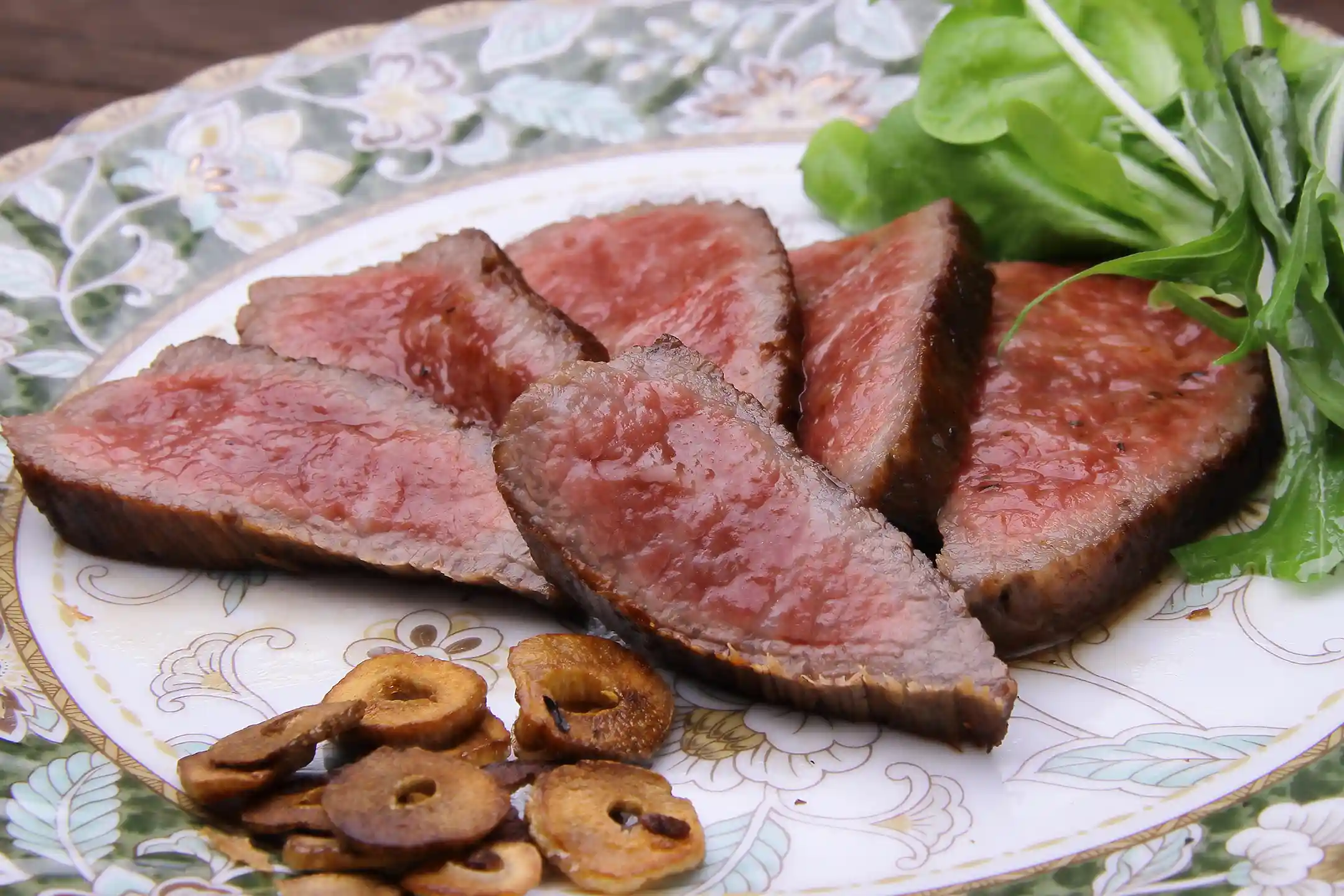Compared with Western steak culture, Japan places special emphasis on the live performance of grilling meat right in front of the guest. For many Western visitors, the first encounter with a teppanyaki steak grill heightens the expectation of experiencing something uniquely Japanese. Yet alongside this freshness and surprise, stereotypes can arise—seeing an unfamiliar culture through a single lens or putting the other on a pedestal. A balanced understanding of the history, craftsmanship, and regional traditions behind the experience helps avoid such pitfalls.
Rich, melt-in-your-mouth marbled Wagyu is Japan’s pride and a world-class gourmet treasure. Among Wagyu, only Tajima cattle that satisfy stringent standards earn the name Kobe Beef, a brand so rare it maccounts for only a sliver of domestic beef consumption. Behind Wagyu’s excellence lie meticulously managed bloodlines and the devoted care of producers. When these are combined with a chef’s dazzling skills on the teppan before your eyes, all five senses are enthralled. This article explores everything from the distinctions between Kobe and other Wagyu, to breeding methods, to the best ways to enjoy teppanyaki steak—revealing the full appeal of Japan’s premium Wagyu while offering hints for deepening mutual cultural understanding.
Types of Premium Wagyu and Their Appeal
When you hear the word “Wagyu,” you’re looking at beef from four native Japanese breeds—Japanese Black, Brown, Shorthorn, and Polled. More than 200 regional brands exist, but Kobe, Matsusaka, and Ōmi headline the “Three Great Wagyu.”
Take Kobe Beef: only pure-bred Tajima cattle that meet precise criteria may bear the name. These champions make up less than 0.2 percent of Japan’s beef supply, yet they deliver intricate marbling whose low-melting fat dissolves the moment it touches your tongue.

Savoring Wagyu becomes even more rewarding once you know why it tastes the way it does. Japan long avoided eating meat; cattle served mainly in the fields, not on the plate. Meticulous breeding flourished nevertheless, laying the groundwork for today’s luxury beef. Contrast that with Western food history, where red meat has been a daily staple for centuries, and you’ll appreciate how differently each culture relates to livestock—and to the pleasure of steak.
The Importance of Breeding and Bloodline Management
Every luscious bite of Wagyu you enjoy traces back to breeders who log each sire and dam, monitor physique, and grade meat quality with scientific precision. Elite sires’ frozen semen travels the nation, ensuring consistent excellence.

On the farm, cattle live more comfortably than you might expect. Some producers pipe in soft music or offer a chilled beer on hot summer days, believing relaxed animals yield silkier marbling. The old saying “seventy percent bloodline, thirty percent rearing” still guides their work, but in reality the split feels closer to a passionate 100 percent on both counts.
Unlike many large Western ranches, Japanese Wagyu often comes from small, family-run operations. Generation after generation refines a shared “eye” for cattle, embodying the meticulous care you taste on the plate.
Flavor by Cut and Ideal Doneness for Teppanyaki Steak
Each cut tells its own story. Marbled sirloin or rib-eye balances buttery fat with robust red meat, while fillet (tenderloin) offers lean, almost ethereal tenderness.

For teppanyaki, chefs typically sear richly marbled cuts over fierce heat, then serve them medium-rare so the fat turns liquid and coats your palate. Leaner fillet stays juicy at rare to medium-rare. Because Wagyu fat boasts a lower melting point than most Western breeds, even gentler cooking unlocks remarkable depth, reflecting Japan’s pursuit of the “ultimate flavor.” If you usually order well-done steak at home, consider the chef’s suggestion here—it’s an invitation to experience Wagyu at its brightest.

Teppanyaki Steak as a Fusion of Cuisine and Japanese Culture
Culinary Art Born of Craftsmanship
Watching a skilled teppanyaki chef feels like attending a private recital. The hiss of Wagyu, the aromatic plume, and the rhythmic knife work echo traditional performing arts. Every practiced motion turns steak into edible choreography created just for you.
Space and Interior Design
Most teppanyaki restaurants place you at a sleek counter, the culinary equivalent of front-row seats at Noh or Kabuki. Smooth timber, polished stone, and subtle lighting frame the grill, marrying timeless Japanese materials with contemporary design. The setting reminds you that this meal is equal parts art gallery and kitchen.

Storytelling and Cultural Insights
Many chefs introduce the cattle’s region or the farmer’s philosophy while they cook. Hearing that story as the aroma rises transforms dinner into what some guests call “education on a plate,” enriching your memory long after the final bite.
A Thorough Guide to Japanese Teppanyaki Steak and Premium Wagyu
Japanese teppanyaki steak and premium Wagyu represent an ultimate gastronomic experience that fascinates gourmets worldwide. Their delicacy—the marbling that melts on the palate and rich aromas—has no equal. Yet behind this luxury lie cultural backdrops and a spirit of blending tradition with innovation. In the West, steak often conjures images of bold grilling; in Japan, teppanyaki evolved as stage-like performance. Through food, cultures meet and appreciate each other’s values.
To avoid misunderstandings born of intercultural encounters, learning the histories cherished by each side is vital. Japan saw a historic shift when meat eating was legalized, spawning new cooking styles. The West, long accustomed to meat, developed diverse seasonings and methods. Understanding these timelines deepens comprehension of differing approaches.
Choosing the Perfect Restaurant for a Luxurious Teppanyaki Steak Experience
The Appeal of Hotel-Based Fine Dining
Five-star hotels across Japan host stellar teppanyaki counters, pairing flawless English support with polished hospitality. A venerable Ginza dining room, for instance, presents chef-selected Kobe Beef while describing each course in multiple languages—a gift if you crave depth without language barriers.
Elements That Create a Serene Atmosphere
Ambience often shapes your memory as much as taste. Traditional teppanyaki counters bring you within arm’s reach of the grill, yet the glow of natural wood and understated lighting cocoons you in calm. This quiet elegance embodies omotenashi and contrasts with the lively buzz of many Western steakhouses.
Selecting a Venue That Expresses Regional Character
With more than 200 Wagyu brands, each region guards its own husbandry secrets. Sampling a local specialty in situ lets you taste the landscape itself—terroir expressed through beef. For many travelers, discovering that connection between place and palate becomes an indelible highlight.

Sustainability and Advanced Technologies

Eco-Friendly Transport and Infrastructure
When planning your journey, choosing the Tokaidō-Sanyō Shinkansen or other high-speed trains cuts CO₂ thanks to renewable-energy initiatives. Increasing numbers of cities are rolling out electric taxis and hydrogen buses, so your steak pilgrimage leaves a lighter footprint.
Making Wagyu Production Sustainable
Some farms now practice “smart grazing.” Sensors and AI track cattle health, while home-grown feed lessens reliance on imports. Organic fodder and careful manure recycling further protect the environment, proving that indulgence and responsibility can share the same plate.
Energy-Saving and Food-Loss Measures in Restaurants
High-end teppanyaki kitchens invest in induction burners and precise portioning to curb waste. Many now encourage diners to take home any remaining steak—a happy fusion of Western doggy-bag culture and Japanese respect for ingredients.
Conclusion
The allure of teppanyaki steak woven with premium Wagyu and Japanese culture rests on multiple layers. Centuries of bloodline stewardship and attentive husbandry yield fine marbling and profound flavor. Add the live performance of grilling, elegant interiors, and the chef’s artistry—expressions of Japanese aesthetics and omotenashi—and the result is an incomparable feast.
Sustainable practices and cutting-edge technology are essential to carry this luxury forward. From energy saving to food-loss reduction, diverse efforts combine so Wagyu and teppanyaki can keep evolving.
A comparison with Western culture shows the importance of learning each other’s backgrounds rather than viewing differences as curiosities. Premium Wagyu teppanyaki is more than haute cuisine; it distills Japanese history, technique, regional character, and modern sustainability into one plate. By appreciating these stories, travelers can savor Japan on a deeper level and share new discoveries through food while respecting one another’s cultures.
Author Bio





.webp)
.webp)